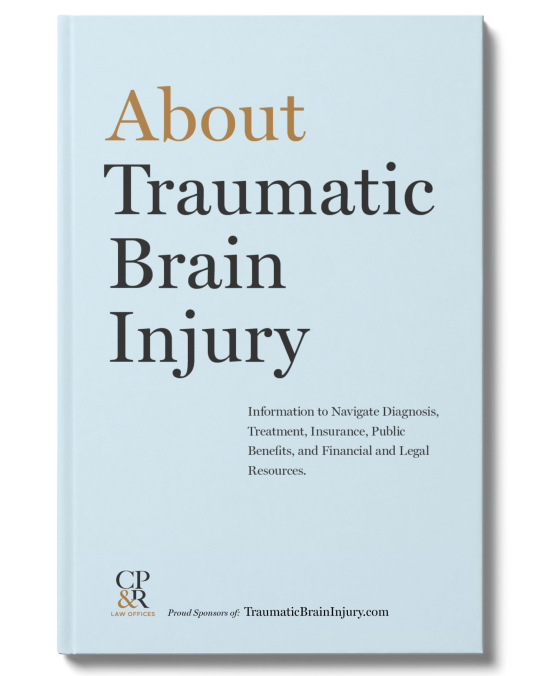A Guide to Health Insurance and Government Benefits
Strategies for understanding health insurance and securing vital benefits and services — some of the most monumental tasks facing TBI patients and their caregivers.
Want to learn more about navigating health insurance and benefits related to a TBI?

If you have personally suffered a Traumatic Brain Injury — or you are caring for a loved one who has — it is critical to understand all applicable health insurance and benefits, including private and government health insurance plans, long-term rehabilitation benefits, home-care benefits, short and long-term disability policies, and government assistance.
Hospitals, rehabilitation and nursing facilities, home health care providers, all require information about insurance coverage. The type of coverage the patient has will dictate key aspects of their treatment, discharge, rehabilitation and future care.

That means you must study policy exclusions, definitions, limitations and treatment guidelines. And most importantly, you need to develop strategies to overcome the potential roadblocks to receiving the treatment that is necessary.
Want to learn more about navigating health insurance and benefits related to a TBI?

Health Care Law Post-2010: The Patient Protection and Affordable Care Act
The Patient Protection and Affordable Care Act, commonly known as the Affordable Care Act (ACA) and often dubbed Obamacare, was enacted in 2010 and expanded in 2014. The ACA is based on the principle that all Americans should have access to affordable health care. The goal of the ACA was to extend health coverage to uninsured Americans, which was estimated at about 47 million individuals in 2010.
The ACA significantly improved health care for individuals with disabilities by expanding access to essential services and protections. A key initiative of the ACA was to prohibit insurance companies from denying coverage based on preexisting conditions. The effect of this provision on individuals with disabilities cannot be underestimated; this was a major barrier for individuals with disabilities who needed to obtain health coverage. After the ACA became law, people with disabilities could secure insurance and could also benefit from essential health services without the fear of exorbitant costs or gaps in coverage.
In addition, the ACA established health insurance exchanges, which provide a platform for individuals to obtain coverage that might have previously been unaffordable or inaccessible. Exchanges allow many to enroll in plans that offer comprehensive benefits for managing chronic conditions associated with disabilities.
The ACA also had a substantial impact on Medicare and Medicaid by reducing out-of-pocket expenses for medications under Medicare and expanding Medicaid eligibility to a broader population. The ACA encouraged preventive services without co-pays or deductibles, thereby promoting early detection and management of health conditions, and influenced quality of care by incentivizing health care providers to focus on quality improvement initiatives.
Finally, the ACA significantly improved long-term care insurance by requiring insurers to cover a wider range of essential health benefits, including preventive services and rehabilitation, which can greatly benefit individuals with catastrophic TBI that need long-term care. Under the ACA, long-term care recipients are more likely to have better access to treatments and rehabilitative services without incurring overwhelming out-of-pocket costs.
Although there have been many legal challenges, and it will no doubt continue to be part of the political debate about health care in the foreseeable future, the ACA remains the law and has been successful in expanding access to affordable, comprehensive health insurance coverage and reducing the nation’s uninsured rate to the historic low of 7.7 million individuals in 2023.
Sources: The Affordable Care Act in Depth, RAND, last accessed October 17, 2024; New HHS Report Shows National Uninsured Rate Reached All-Time Low in 2023 After Record-Breaking ACA Enrollment Period, US Department of Health and Human Services, last accessed October 17, 2024
Private Health Insurance Coverage
If you are at a hospital and know there is private health insurance coverage but do not have the details of the policy, you can confirm coverage by contacting the insurance company directly at its toll-free number. There are also staff members at a hospital who are available to call the insurer on your behalf to confirm coverage. Alternatively, you may try to locate this information from a brochure or other document that was provided by the sponsoring employer, or by calling the employer’s human relations or benefits department.
However, our experience is that the coverage information provided is often inaccurate, out of date, incomplete, or misleading. To fully understand a health insurance policy, you must get a copy of the Master Health Insurance Policy. This document needs to be thoroughly reviewed. Insurance coverage is established by the definitions, terms, and exclusions in that Master Health Insurance Policy. An insurance policy is a contract, and the devil is always in the details of that contract. Plan descriptions, telephone calls, and brochures do not provide the details you need to fully understand the policy, or an insurer’s denial of benefits and services. You need a copy of the Master Health Insurance Policy. Understanding the policy will guide decisions about care, treatment, and decisions about appealing denials of benefits. The policy dictates the care that will be provided under the contract, and the level of care can make a difference in a patient’s recovery.
Private Health Insurance Policies Available Through the ACA Marketplace and Employer-Sponsored Private Plans
Health Maintenance Organizations (HMOs) arrange managed care for health insurance, including self-funded health care benefit plans, on behalf of individuals and others and acts as the liaison between medical providers (doctors and hospitals) on a prepaid basis. These plans typically require members to select a primary care physician and obtain referrals for all specialty care. HMOs are adapting to competition by offering more comprehensive coverage and a wider network of health care providers. The HMO covers care provided by medical professionals, who receive a steady stream of income in exchange for treating patients in accordance with the HMO’s written guidelines. HMOs provide emergency care, regardless of the medical provider’s participation in the plan, but with restrictions.
While the cost of HMOs is lower, the concerns about HMOs include higher out-of-pocket costs; the cost of emergency treatment, which must meet certain conditions to qualify; the requirement that participants use-in network providers to get coverage; and the need for referrals from primary care physicians to see a specialist, who is dictated by HMO guidelines.
Preferred Provider Organizations (PPOs) allow patients greater flexibility to choose health care providers within a network because they do not require physician referrals. PPOs also generally provide broader coverage and allow for out-of-network care.
While the PPOs offer more flexibility to choose medical providers, the concerns about PPOs include that PPOs cost more than HMOs; a PPO is more likely to have an annual deductible than an HMO; PPO members pay a higher coinsurance fee than under an HMO for seeing a doctor outside of the network; increased paperwork when patients see out-of-network providers; and patient responsibility for coordinating care because PPO patients choose their own medical providers, unlike HMOs that make the primary care physician responsible to coordinate care.
Exclusive Provider Organizations (EPOs) combine certain features of HMOs and PPOs. EPOs offer a network of preferred providers for covered services. EPO health plans do not typically provide coverage for out-of-network care except in emergencies. EPOs focus on so-called cost-effective strategies and preventive care initiatives to improve health outcomes; this focus may result in barriers to obtaining coverage, as further discussed below.
Common concerns about EPOs include additional out-of-pocket expenses; limited full coverage alternatives; the need to find a new primary or specialist doctor; substantial deductibles; lack of coverage outside of the network; and numerous network constraints.
High-Deductible Health Plans (HDHPs) work with Health Savings Accounts (HSAs) to allow individuals to save for medical expenses tax-free. An HSA is a savings account that allows individuals to save for qualified medical expenses. HSA contributions may be made by the individual or their employer and are limited to a maximum amount every year. These plans feature lower premiums and higher deductibles, making them suitable for those who prefer control over their health care spending and can afford high deductibles. HDHPs with HSAs generally emphasize wellness programs and telehealth services for preventive care.
HDHPs likely will reduce monthly premiums over other options, but there are some downsides, including large medical out-of-pocket costs in the event of unforeseen hospitalization. In addition, due to the high deductibles, patients may refrain from seeking treatment or prescriptions not covered by the plan, which can lead to other health problems. Since people with severe brain injuries may require hospitalization or other long-term treatment, it is important to determine whether you have access to the funds needed to pay the out-of-pocket maximum deductible required when considering a HDHP.
The Consolidated Omnibus Budget Reconciliation Act (COBRA) refers to a federal law that allows individuals and their dependents to continue their employer-sponsored health insurance for a limited time after certain qualifying events, such as job loss or reduction in work hours. One of the primary benefits of COBRA insurance is that it provides a safety net for those who may need temporary health coverage, thereby ensuring access to necessary medical services.
A significant limitation of COBRA coverage is that individuals must pay the full premium themselves, which can be a substantial financial burden. In addition, COBRA coverage is only a temporary solution because it is generally only available for 18–36 months, after which individuals must secure alternative health insurance.
Government Benefits: Medicaid
Medicaid is a government health benefit program in the US for eligible individuals with both low income and resources — poverty alone does not qualify an individual for Medicaid. The program is individually operated by each state and funded by each state with matching dollars from the federal government if the state conforms to federal Medicaid guidelines.
To qualify for Medicaid benefits, individuals must meet specific eligibility criteria established by each state. In forty states and the District of Columbia, Supplemental Security Income benefits (SSI) awardees are categorically eligible for Medicaid. In the remaining states, individuals must apply for Medicaid benefits either after SSI benefits are granted or in addition to an SSI application. SSI is a cash benefit program and will be discussed later in this chapter. Generally, the eligibility criteria used includes income levels, assets, household size, disability status, citizenship status, the severity of the injury and its effect on the patient’s activities of daily living. Medical assessments, including documentation from health care providers and functional assessments, are also used to determine eligibility for individuals with TBI.
Each state is responsible for the implementation, coordination, and oversight of the program, and many states use private companies to administer portions of the Medicaid program, called Medicaid Managed Care. During the application process, individuals will need to provide documentation of their income, assets, residency status, and medical diagnoses. Medicaid information is available and applications can be made in most states online, in-person, and phone assistance options are available.
A common barrier to Medicaid applications pertains to the assets possessed by an individual either individually or jointly, most typically a home. Before 2005, the family of an individual seeking Medicaid would often attempt to give or transfer their home to others in the family for little or no money. By doing so, the individual would meet the financial requirements for Medicaid and avoid having to repay medical costs from the sale of the home later. However, in 2005, Congress passed the Deficit Reduction Act (DRA), which significantly changed the rules governing transfer of assets. The DRA established a five-year “look-back” period, which allows the government to look back at any transfers of assets for less than fair market value in the five years before the application. In other words, if a home or other assets were gifted or transferred at a discounted price, the government may reject the Medicaid application.
Medicaid eligibility is not limited to US citizens. Noncitizens who meet certain criteria may qualify for Medicaid benefits. The specific rules and requirements for Medicaid coverage for noncitizens varies by state and depends on factors such as immigration status, length of US residency, and other considerations.
For example, lawful permanent residents (green card holders) who have met the required residency period and other eligibility criteria can typically qualify for Medicaid coverage. Humanitarian immigrants, such as refugees and victims of trafficking, may be eligible for some Medicaid benefits as well. Undocumented immigrants have more limited access to Medicaid benefits, and their entitlement depends on state-specific rules and federal regulations.
People with TBI who qualify for Medicaid gain access to rehabilitation therapies to improve cognitive function, emotional well-being, and overall quality of life. The therapies available under Medicaid would likely not be available (or would be severely limited) under a private insurance policy. These services include physical therapy, occupational therapy, speech/language therapy, cognitive rehabilitation therapy, behavioral therapy, vision (vestibular) therapy, nutrition counseling, psychological therapy, neurofeedback therapy, vocational rehabilitation, recreational therapy, and nursing home care.
Applying for Medicaid Benefits
When applying for Medicaid benefits, people with TBI, particularly individuals with mild TBI or PCS, need to follow a detailed approach that includes gathering a complete copy of all medical records, and contacting providers and detailed letters of medical necessity. Medical records must clearly describe and confirm the diagnosis, prognosis, severity, impact, and the ongoing requirements to care for the individual. Records must also demonstrate the medical necessity of specific treatments, therapies, and interventions to support recovery, improve cognitive function, and enhance quality of life post-injury.
Medicaid Benefits: Early and Periodic Screening, Diagnosis, and Treatment Services for Children and Adolescents
The federal government program known as Early and Periodic Screening, Diagnosis, and Treatment (EPSDT) provides Medicaid-eligible children and adolescents under the age of 21 with comprehensive and preventive health care services. EPSDT requires states to provide certain necessary medical services to children and adolescents, even if those services are not available under the state’s Medicaid plan for adults, including early detection, intervention, and treatment of health conditions, as well as developmental screening, diagnostic, and treatment services.
The Medicaid EPSDT program provides even more coverage than the typical private insurance plans, managed care, or HMO plans. It increases access to services designed to improve a child’s quality of daily life. Moreover, EPSDT requires states to actively arrange for treatment, which of course is more than merely offering to pay for those services if, as and when they are available.
Children with complex medical needs, such as cerebral palsy (CP), TBI, ventilator dependency, and spinal cord injuries are routinely denied services by private health care insurers because necessary equipment, therapies, rehabilitation programs, or nursing care are not provided under the terms of those health insurance policies. Under the Medicaid EPSDT program, children receive the necessary medical care, and eligibility for this care is broad. Care must be covered under EPSDT if the treatment will correct or improve a condition from worsening, even if the condition cannot be cured. Further, unlike private health insurance, the determination of whether the requested service is medically necessary is made primarily by the treating physician and not based on an evaluation by an “expert” in the employ of the private insurance company.
The services offered under EPSDT include early and periodic screenings that encompass a comprehensive set of assessments for early evaluation of a child’s physical, emotional, and developmental well-being. These screenings may include medical exams, vision and hearing tests, developmental assessments, behavioral health screenings, and other evaluations to identify health issues, developmental delays, and risk factors.
Following screenings, EPSDT services focus on diagnosing and evaluating identified health concerns, including developmental delays, thorough assessments, diagnostic tests, consultations with specialists, and multidisciplinary evaluations. The goal is to provide an accurate diagnosis and determine appropriate interventions tailored to the individual needs of each child.
A wide range of comprehensive treatment services are available to address identified health issues, including medical treatments, therapies, mental health services, dental care, vision services, hearing services, and other interventions necessary to promote a child’s health and well-being.
In addition to addressing existing health issues, EPSDT emphasizes preventive care and health promotion through immunizations, well-child visits, health education, nutrition counseling, and other services to help develop healthy habits, prevent diseases, and promote overall health for children and adolescents.
Medicaid Benefits: Home and Community-Based Services Waivers
An HCBS waiver is a Medicaid program that provides support and services to individuals who require long-term care but wish to receive it in their homes or communities rather than institutional settings. HCBS waivers aim to promote independence, enhance quality of life, and enable individuals to receive the care and support they need while remaining in familiar surroundings.
Through this program, certain Medicaid requirements can be set aside (or waived) to provide individuals with long-term care services in their homes or communities instead of in nursing homes or other long-term care settings. States can offer a range of services and support to meet the specific needs of individuals who require long-term care. Because these waivers are administered at the state level through each state’s Medicaid agencies, waiver programs vary in terms of services offered, eligibility criteria, and application processes. To apply for HCBS waivers, individuals must typically contact their state’s Medicaid agency or designated waiver program office. The application process generally involves completing forms, providing documentation of eligibility, participating in assessments or evaluations, and demonstrating the need for long-term care services. Like every other Medicaid application process, detailed documentation is required.
Common services included in HCBS waivers include home health aide services; homemaker services; personal care services; rehabilitation services, personal care assistance; respite care; adult day care services; case management; assisted-living services; transportation assistance; home modifications; meal delivery services; and behavioral health services. However, in some cases, individuals can obtain approval for services that are not explicitly listed under the HCBS waiver program. States have processes in place to review and approve additional services on a case-by-case basis to meet the unique needs of individuals requiring long-term care. This flexibility allows states to address specific care needs so that individuals can receive the necessary support to remain living in their communities.
HCBS waiver programs are typically available to children, adults, and older adults who require long-term care and meet the eligibility criteria set by their state’s Medicaid program. Eligibility requirements may vary by state and consider factors such as medical condition, functional abilities, income level, and need for assistance with activities of daily living. Medicaid waiver programs are important because they allow for creative alternatives to institutional care for Medicaid-eligible individuals.
HCBS waivers have an entirely different approach than traditional Medicaid assistance and focus on community-based services. While HCBS waivers have certain advantages in terms of personalized care, cost-effectiveness, and individualized support, they also face challenges related to access, coverage limitations, administrative complexity, and funding constraints.
Government Benefits: Medicare Coverage and Income Benefits for the Disabled Under 65
Medicare provides comprehensive coverage and a range of services to support health care needs. Medicare was originally established to provide health insurance coverage to eligible senior citizens over age 65, and because it is funded through federal Social Security taxes, there is no qualifying income limit.
Medicare can also cover those under age 65 who qualify for and receive Social Security Disability Insurance (SSDI) benefits, which is discussed in the next section of this chapter. In general, qualified individuals under the age of 65 who have a disability become eligible for Medicare two years after an SSDI application (with some exceptions). Qualifying disabilities can include a TBI or other health conditions that prevent an individual from working and accessing an employer-sponsored health plan.
Social Security Disability Insurance Benefits
SSDI is a Social Security Administration (SSA) program that pays cash benefits. Like SSI, discussed in the next section, it provides financial assistance for those who are unable to work because of a disease, illness, injury, or disability. Although they are somewhat similar, there are key differences.
To qualify for SSDI, the individual must have a record of work and paid taxes into Social Security long enough to be entitled to benefits, be diagnosed with a disease or medical condition that is classified as an impairment by the SSA, and be disabled from performing basic work activities. Disabled children and spouses of a qualifying worker may also be eligible for benefits.
- Monthly Cash Benefits: Eligible individuals receive monthly cash benefits based on their work history and the severity of their disabling condition. These benefits help replace lost income and provide financial support to individuals and their families.
- Medicare Coverage: Individuals who receive SSDI benefits are eligible for Medicare after a two-year period, which helps pay medical expenses and provides access to essential health care services.
- Dependent Benefits: In some cases, family members of the disabled worker, such as spouses and children, may be eligible to receive dependent benefits based on the worker’s SSDI record.
The process of applying and qualifying for SSDI benefits involves several steps to determine eligibility. Individuals can apply for SSDI benefits online, by phone, or by visiting a local Social Security office. The application requires detailed information about the applicant’s work history and medical condition. The application must be supported by comprehensive medical documentation, including medical records, as well as reports from the treating physicians. To be awarded SSDI benefits, the reports of the treating physician and medical records must define the applicant’s medical condition as disabling, consistent with SSA’s classifications.
Not all doctors or medical offices are familiar with the SSA classifications, and it is important to review any medical report before it is submitted. It may seem obvious, but to qualify for the medical benefits the treating doctors must submit a report that describes the injury, diagnosis, treatment, and functional disability in sufficient detail, and point to objective evidence (tests, studies, consultations, and evaluations) so that the condition qualifies as a SSA classified disability. A poorly worded or scant report can lead to a denial and complications. An advocate or a disability lawyer can be of assistance to individuals, families, and medical providers in this situation.
Supplemental Security Income Benefits
SSI, like SSDI, is administered by the SSA, and the program provides benefits for adults and children that have limited income and resources who meet the SSA’s requirements for a qualified disability. Eligibility for SSI is based on age, disability, location, income, and assets. Unlike SSDI, work history is not a factor. The program is designed to supplement monthly income and provide other benefits for anyone of any age who is blind or disabled and anyone with low income and resources over age 65.
SSI’s income and asset limitations include cash in bank accounts, life insurance policies, home or other real estate, and personal property. It will also consider wages, pensions, and other Social Security benefits received by either the disabled person or their spouse. In addition, the location where the applicant resides is a factor in determining eligibility.
Adults seeking SSI benefits must demonstrate that they are unable to engage in substantial gainful activity due to their medical condition. An adult applicant must also meet specific income and resource criteria set by the SSA. Medical documentation and evidence from health care providers are, as always, vital to prove the severity of the disability and its impact on the individual’s ability to work.
Children with disabilities may qualify for SSI benefits if they meet the SSA’s criteria for disability. A child’s impairment must result in severe functional limitations that are expected to last for at least 12 months or result in death. In general, medical eligibility requirements for children focus on the disability’s impact on daily activities and the child’s ability to perform those activities independently. Additionally, the child’s family income and resources must fall within the program’s limits.
Know Your Legal Rights
In today’s world, families, caretakers, and individuals with TBI (as able) must fight for their rights to compel insurers to live up to their obligations under the insurance policy.
If you are considering a lawsuit related to a private and government insurance claim or appeal, it must be filed within certain time limitations. Those time limits are established by law. The failure to follow these deadlines can result in an injured person losing their right to ever pursue a claim for damages or benefits or the right to appeal the denial of benefits. Injured people and their families must be aware of and abide by these deadlines.
It is essential to seek legal counsel promptly after a TBI to ensure compliance with statutes of limitations and to protect legal rights.
Experienced brain injury lawyers guide individuals through the complexities of the legal system and help them navigate the claims process efficiently.
Need help investigating your legal rights related to a traumatic brain injury?
Speak to an experienced brain injury attorney team like Cohen, Placitella & Roth.
For five decades, CPR has successfully represented individuals and families in TBI cases nationwide working with qualified co-counsel.


Get Our Free Traumatic Brain Injury Book
To learn more about Traumatic Brain Injury request our comprehensive book, available for free directly to your inbox



